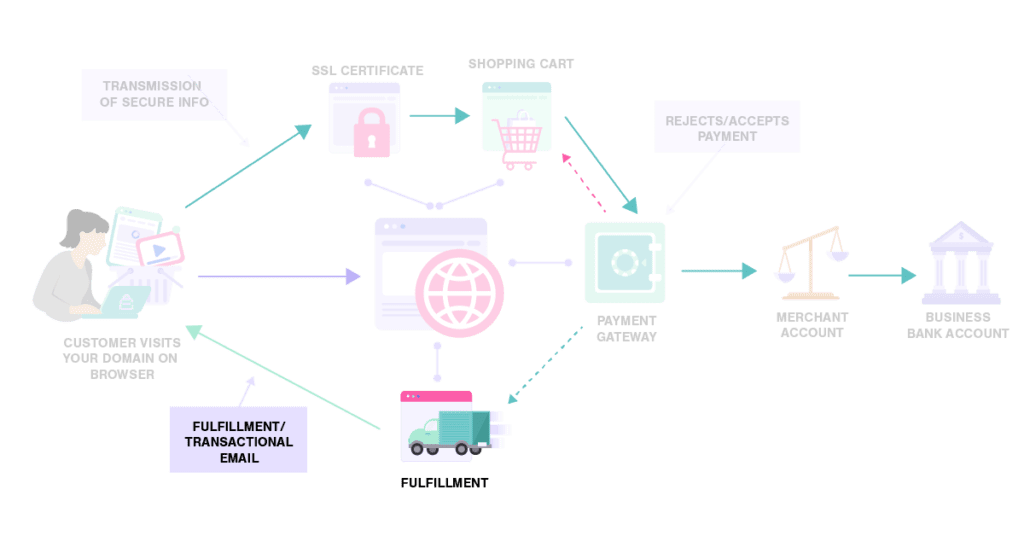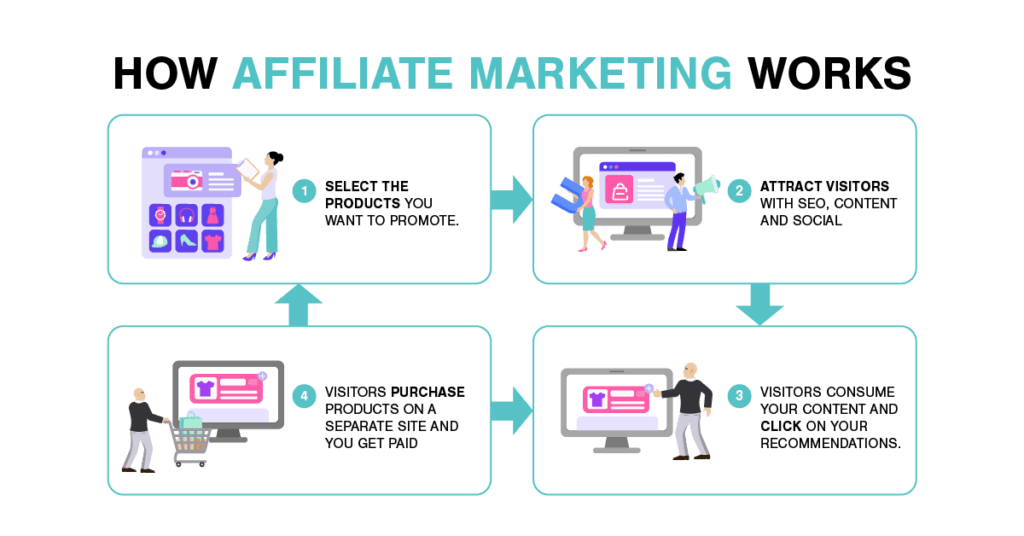As ecommerce sales continue to grow, the online marketing game is heating up as more businesses invest in digital ads and social media campaigns. If you want your slice of the pie, it will take hard work and persistence to edge out the competition.
Fortunately, you aren’t alone. Ecommerce marketing is a vast industry and can quickly become underwhelming for the uninitiated.

In this article, we will discuss the theory and practice of marketing your ecommerce company. No matter your level of experience, these ecommerce marketing tips can help you get started crafting your epic ecommerce marketing strategy!
Ecommerce Marketing Defined
Ecommerce marketing can be considered any practice intended to drive traffic and sales to an online store. This can include traditional tactics like promotional emails and display ads or new tactics like viral videos and influencer marketing.
Benefits of an Ecommerce Marketing Strategy
There are countless ways to promote your ecommerce business, but going in blind is rarely an effective or efficient business strategy. Preplanning can help you develop consistency and synergy among your tactics to get the best results for your effort and budget. Remember to work smarter, not harder, when marketing your brand.
What Makes an Effective eCommerce Marketing Strategy?
Whatever you decide to focus on as part of your marketing strategy, you want to do it well. You will be better off mastering a few marketing tactics than trying to do everything at once. Below are some tips to keep in mind when implementing your ecommerce marketing strategy.
Creating Engaging Content
The value of engaging content cannot be overstated. One of the best marketing strategies there revolves around creating different forms of content for free. Why? Because providing value to your audience via high-quality content attracts website visitors, builds brand awareness, and establishes your authority in that field.
Getting to Know Your Customers
It’s hard to create engaging content if you don’t know whom you’re creating it for. The first step is to decide who your ideal customer is, then research to learn more about them, and finally connect with them on a personal level. Once you know who your customers are and what motivates them, it becomes much easier to make business decisions that will benefit them.
Knowing Not Every Platform Is for You
Once again, it is better to master a few strategies than try to do everything and fail. Just because other brands have succeeded with one method or ecommerce platform doesn’t mean it will work for you. There probably aren’t a lot of users on TikTok interested in learning about lawnmowers; direct that effort elsewhere.
Reaching Out to the Right Advocates for Your Products
One of the best ways to accelerate business growth is by letting others help you. This is precisely why social media strategies and influencer marketing are so effective. Many marketing strategies rely on budgeted maximums and predictable returns on investment. Word of mouth has the potential to expand your reach exponentially. That doesn’t just mean going viral, but word-of-mouth marketing can trigger serious growth and reach untapped communities of people.
How to Build an Ecommerce Marketing Plan
Building an effective ecommerce marketing plan requires forethought and strategy. The decisions you make during the planning phase will guide you throughout the rest of the process. Give careful thought to your goals, ideals, and audience, so you truly understand the direction of your efforts.
Create an Executive Summary
An executive summary should summarize the key points of your overall digital marketing strategy. This includes overarching goals and guidance on how to achieve them. The benefit of an executive summary is it can be given to team leaders to ensure everyone is on the same page and working toward the same business objectives.
Set Specific Goals and Objectives
While you may not have room to get overly specific about each goal in the executive summary, your marketing campaigns’ bottom-line goals and objectives should be very specific. Each team and team member must know what is expected of them so that they can focus their efforts on accomplishing their individual goals and the overall success of the company.
Declare a Mission Statement and Value Proposition
A mission statement can be a powerful thing for a company. Not only does it help define the goals and values of the organization for internal use, but it can be a powerful tool for PR and marketing. If you want to stand out among the competition, tell your audience who you are and why you do what you do. It will help them connect with and remember your brand.
Target the Right Customers, Personas, and Markets
It is difficult to effectively market to your target customers if you don’t completely understand who that is. Customer personas go beyond basic demographics like age, gender, and location. You want to connect with your audience on a personal level, including their online habits, interests, and values. It is also important to know that your current customers aren’t necessarily your ideal target audience.

Perform an Analysis of the Company’s Current State
Similarly, it is challenging to move forward with your marketing efforts if you don’t fully comprehend the current status of your brand. Understanding your strengths and weaknesses will help you decide how to focus your efforts. This includes knowing the strengths and weaknesses of your competition so you can identify opportunities.
Make Sure Your Pricing Is Fair and Reasonable
Along with researching the competition, you need to know where your offerings stand as far as pricing and value. Marketing can only do so much for you if the competition offers similar products at half the price. Shopping around is abundantly easy in the digital era, so you need to know your brand’s position when it comes to pricing. Are you the cheapest game in town, or do you provide quality service that makes shopping with you worth paying a premium?
Put Together a Distribution and Fulfillment Plan
Knowing how you will ship and fulfill orders is obviously important for your business procedures, but it can also impact your marketing. Do you offer free shipping? Do you ship orders fast? These are major selling points, but it depends on your fulfillment processes. Your methods are likely to evolve as your business grows, so keep an eye out for opportunities to provide better service with less work on your part.

Executing an Ecommerce Marketing Strategy
Now that you have a complete understanding of your business and customer base, you are in a good position to plan and execute your digital marketing strategy. Don’t get too caught up in doing things by the book. Remember the core values of your brand and audience and keep them in mind at every stage of marketing.
Decide on a Lead Generation Strategy
Lead generation is the act of attracting and vetting potential buyers. There are many online marketing channels for generating leads, so it is important to consider which methods will work best for your business. You can also combine different tactics, like content marketing and social networks, for a more effective overall ecommerce strategy. Be sure to have a landing page with a well-designed lead capture form where you can direct traffic.
Invest in Technology and Reporting Software
You should already be using some form of reporting software, like Google Analytics. After all, you can’t really improve your marketing if you aren’t measuring the results of your efforts. As your efforts and tactics grow, so too should your technology and marketing tools. Being able to accurately measure KPIs and automate processes gives you the freedom to focus your efforts on what is working. Remember, digital marketing is about working smarter, not harder. Marketing automation rules can help.
Begin With a Conversion Strategy
Conversions are one of the most important metrics in ecommerce marketing, yet somehow many companies categorize it elsewhere. The goal of marketing is, of course, growing traffic to your website, but that traffic means nothing if no one is converting. In many cases, companies are better off focusing their efforts on conversion rate optimization and average order value for existing customers than trying to drive more traffic with low conversions.
Run Some Tests
Tests are another great way to measure and improve your marketing success. A/B testing is a common tactic many marketers and web designers use to optimize a digital storefront. Again, it can be tempting to dive in and get tunnel vision when it comes to marketing, but don’t lose sight of the results!
Perfect and Improve Your Ecommerce Marketing Plan
The deeper you get into marketing, the more you will learn. Your ecommerce business plan shouldn’t be set in stone, restricting your future options. As you learn and grow as a marketer, your ecommerce marketing strategy should grow and evolve too. Don’t be afraid to try new things, keep what works, and ditch what doesn’t.
E-commerce Marketing Strategy Examples
The ecommerce marketing game is constantly evolving. The ecommerce landscape looked very different ten years ago, and ten years from now, it will be unrecognizable again. This is why ecommerce marketing isn’t a one-and-done task but an ongoing process. Below are some mainstays in the realm of ecommerce marketing that you can leverage for your company’s success.
Search engine optimization (SEO)
Search engine optimization is one of the best ecommerce marketing strategies. It can require hard work, commitment, and specialized knowledge, but an investment of time or paying for an agency will pay dividends well into the future. This is one of the best investments you can make for your ecommerce business.
Paid advertising
Paid ads are an obvious tactic for increasing traffic to your ecommerce website. There are many different options for what types of ads to use and where to run them. Videos ads on YouTube, sponsored posts on Facebook, or display ads on other websites are just a few examples.
User-generated content
User-generated content is a great way to connect with your business audience. As a bonus, you score free content to share on your website and social media platforms, such as customer testimonials. User-generated content acts as social proof for potential buyers. If it’s fun or interesting, you’ll probably get some shares too!
Social media marketing
Traditional forms of marketing are quickly losing out to modern practices. One of the most important new forms of marketing involves social media and influencers. Whether you are trying to go viral, get in front of a vast audience, or just connect with potential customers where they like to spend their time, social media marketing is too important to ignore.
Influencer marketing
Influencer marketing is a newer concept that leverages the pre-existing reach of celebrities and social media influencers to get your ecommerce brand in front of an active audience. There are many different angles when it comes to influencer marketing, such as product reviews or sponsorships. Still, the aim is the same: partner with a famous personality to promote your company or products.
Email marketing
Email campaigns are one of the oldest and most dependable forms of ecommerce marketing. Many businesses invest big money in growing an email list as an advertisement distribution channel. These could be new product launch notifications, abandoned cart emails, or post-purchase follow-up emails.
Content marketing
Digital content marketing is the strategy of creating relevant content with target keywords in hopes of attracting your target customers and getting them started in your marketing funnel. Common examples include writing blog posts and creating how-to videos that answer questions your potential customers have to expose them to your brand and online products.
Affiliate Marketing
Affiliate marketing is a simple but effective idea. Essentially, the concept revolves around paying a commission to affiliates who promote your brand. Every time a customer gets directed to you from an affiliate’s unique link and converts, that affiliate earns a cut. Setting up an affiliate program can take some work, but after the initial investment, you can see a huge boost in online sales with relatively little oversight.

Tips for Successful Ecommerce Marketing
While many factors go into a successful ecommerce marketing strategy, here are some things to keep in mind throughout the process:
Use Personalization
Internet users are bombarded with blanket ads all day long. If you aren’t using tracking cookies for retargeting campaigns, intentional product ad placement, or personalized subject lines, your ads will just be white noise with low click-through rates.
Don’t Underestimate User-Generated Content
User-generated content has two major benefits: First, it’s essentially free since users create and distribute it for you. Second, it’s authentic. Some people are reluctant to trust new brands, but if their peers engage with your content, they will feel more comfortable.
Consider Creating Loyalty Programs
Customer loyalty programs are an effective long-term strategy for customer retention and attraction. Some shoppers will be encouraged by rewards (new customer discounts, in particular), and growing incentives will motivate loyal customers to continue to shop with you over the competition.
Try Investing in Live Chat
Ecommerce is a game of speed and convenience. Customers looking at product pages online want instant gratification and quick delivery. Those with questions don’t want to send an email and wait for a response or pick up the phone. It’s easier just to shop elsewhere. Live chat messages let sales reps give quick, concise answers and nudge shoppers along their customer journey.
Don’t Overlook the Shopping Cart
Online shopping cart abandonment is a huge deal. You’re losing money if you aren’t tracking these stats on your ecommerce site or figuring out how to lower them. You want your checkout process to be as seamless and inviting as possible. It took a lot of work to get people shopping on your site; you don’t want to lose them on the home stretch.
Improve Your Web Design
User experience can significantly impact your SEO, CRO, and customer satisfaction. While development and design may not be your strong suit, investing time or money into a quality website is almost always worth the investment. Every one of your customers will be using your site for the foreseeable future, don’t settle for “good enough.”
FAQs
Ready to Implement Your Ecommerce Marketing Strategy?
Now that we’ve thoroughly covered ecommerce marketing from the standpoint of theory and execution, you probably have some new ideas you’re ready to implement in your ecommerce marketing strategy.
Ecommerce marketing is an ever-changing game. You have to be willing to roll up your sleeves and try new tactics. They might not all work, but some will, and it will keep you up at night wondering why you took so long to try!









